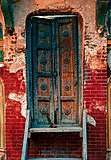Lahore
Lahore (Punjabi: لہور, Urdu: لاہور), pronounced [laːˈhoːr] is the capital of the Pakistani province of Punjab and the second largest city in Pakistan. It is one of the top ancient cities in Sub continent Indo-Pak. Historically the main city of the undivided Punjab, Lahore has been a center of Muslim heritage since Data Durbar is here. It is often called the Garden of Mughals because of its rich Mughal heritage. It successively served as provincial/regional capital of the empires of the Shahi kingdoms in the 11th century, the Ghaznavids in the 12th century, the Ghurid State in the 12th and 13th century, the Mughal Empire in the 16th century, the Sikh Empire in the early 19th century, and it was the capital of the Punjab region under the British Raj in the mid 19th and early 20th century. Mughal structures such as the Badshahi Mosque, the Lahore Fort, Shalimar Gardens, and the mausolea of Jehangir and Nur Jehan are popular tourist attractions for the city. Lahore is also home to many British colonial structures built in the Mughal-Gothic style, such as the Lahore High Court, the General Post Office (GPO), the Lahore Museum, and many older universities including the University of the Punjab. Lahore is often referred to as the Cultural Heart of Pakistan, as it is the center of Pakistani arts, films and intelligentsia.
Historical Landmarks[edit]
-
The Lahore Fort built by Mughal Emperor, Akbar between 1556–1605
-
Tomb of Jahangir built in 1637.
-
Badshahi Mosque, built by the Mughal Emperor, Aurangzeb in 1671.
-
Minar-e-Pakistan, commemorating the site where the Pakistan Resolution was passed.
-
Tollinton Market (Old)
-
The Samadhi of Ranjit Singh, built in 1840s.
-
Bawa Dinga Singh Building
-
Ferozsons Library
-
Data Durbar Shrine complex
-
Asif Khan's Mausoleum
-
Allama Iqbal's Mausoleum
-
Shalimar Gardens
-
Lahore Museum
-
Nau Nihal Singh's haveli, now Victoria Girls High School, Lahore.
-
Government College University
-
The main door of Wazir Khan Mosque's main hall.
-
A Door in Wazir Khan Mosque, leading to "Calligrapher's Bazaar".
Cityscapes[edit]
-
Gawalmandi Food Street, Lahore
-
The Friday Prayers at the famous Badshahi Mosque in Lahore.
-
Sacred Heart Cathedral.
Modern Landmarks[edit]
-
PIA Head Office
-
Eden Heights
Transport[edit]
-
Lahore Metro Orange Line 4
-
Road to Lahore Cantonment
-
Lahore Ring Road
Historical Images[edit]
-
Edwin Lord's painting showing an open-air restaurant opposite the Wazir Khan Mosque
-
Duleep Singh entering his palace
-
Government College University, circa 1880.
-
Street scene of Lahore
-
Chauburji, 1880
Miscellaneous[edit]
-
Government College University's bridge, joining it's two campuses.
-
Government College University's iconic tower, as seen from behind.
-
Government College University's amphitheatre.
-
Hallway in Wazir Khan Mosque that leads to Calligrapher's Bazaar.
-
Government College University's general auditorium, named after Patras Bokhari.
-
Overload's Dhol-Player.
-
One of the four minaret of Wazir Khan Mosque.




































